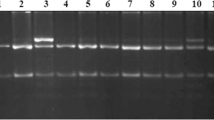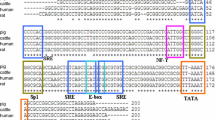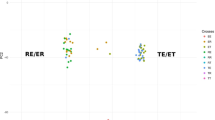Abstract
Porcine chromosome 6 (SSC6) has been reported to have QTL affecting intramuscular fat content (IMF) in multiple populations. The objective of this study was to investigate the effect of FABP3 and LEPR genetic variations as well as their mRNA expression on the IMF trait in a three-generation of Korean native pig and Yorkshire crossed animals. Several polymorphisms of the FABP3 (HinfI, HaeIII and HinfI*) were significantly associated with moisture, tenderness and flavor score (P < 0.05), and were used to construct haploytpes: haplotype 1 (-TCT-) increased the marbling and intramuscular fat content, however, haplotype 2 (-CCT-) decreased tenderness. The LEPR AvaII polymorphism showed significant association with moisture, intramuscular fat, cholesterol and flavor score (P < 0.05). The linkage analyses with six microsatellites mapped FABP3 gene in the interval between the markers Sw1129 and S0228 (Sw1129—11.7 cM—FABP3—9.1 cM—S0228), and the LEPR gene between the markers S0121 and Sw322 (S0121—7.5 cM—LEPR—28.5 cM—Sw322). QTL mapping suggested a significant QTL affecting Moisture (83 cM) and IMF (84 cM) located close to marker S0228. The gene expression results showed that in the loin muscle, both of the FABP3 and LEPR genes showed significantly higher expression in pigs with higher IMF%, however, in the backfat, only FABP3 showed differential expression between these two groups of pigs (significantly higher expression in pigs with lower IMF%) (P < 0.05). In the liver, both of these two genes did not show any difference between the high and low IMF% groups.



Similar content being viewed by others
References
van Wijk HJ, Arts DJ, Matthews JO, Webster M, Ducro BJ, Knol EF (2005) Genetic parameters for carcass composition and pork quality estimated in a commercial production chain 1. J Anim Sci 83:324−333
Fernandez X, Monin G, Talmant A, Mourot J, Lebret B (1999) Influence of intramuscular fat content on the quality of pig meat. Composition of the lipid fraction and sensory characteristics of m. longissimus lumborum. Meat Sci 53:59–65
de Koning DJ, Janss LL, Rattink AP, van Oers PA, de Vries BJ, Groenen MA, van der Poel JJ, de Groot PN, Brascamp EW, van Arendonk JA (1999) Detection of quantitative trait loci for backfat thickness and intramuscular fat content in pigs (sus scrofa). Genetics 152:1679–1690
Koning DJ de, Rattink AP, Harlizius B, Van Arendonk JA, Brascamp EW, Groenen MA (2000) Genome-wide scan for body composition in pigs reveals important role of imprinting. Proc Natl Acad Sci USA 97:7947–7950
Gerbens F, de Koning DJ, Harders FL, Meuwissen THE, Janss LLG, Groenen MAM, Veerkamp JH, van Arendonk JAM, te Pas MFW (2000) The effect of adipocyte and heart fatty acid-binding protein genes on intramuscular fat and backfat content in meishan crossbred pigs. J Anim Sci 78:552–559
Grindflek E, Szyda J, Liu Z, Lien S (2001) Detection of quantitative trait loci for meat quality in a commercial slaughter pig cross. Mamm Genome 12:299–304
Ovilo C, Pérez-Enciso M, Barragán C, Clop A, Rodríguez C, Oliver MA, Toro MA, Noguera JL (2000) A QTL for intramuscular fat and backfat thickness is located on porcine chromosome 6. Mamm Genome 11:344–346
Ovilo C, Oliver A, Noguera JL, Clop A, Barragan C, Varona L, Rodriguez C, Toro M, Sanchez A, Perez-Enciso M, Silio L (2002) Test for positional candidate genes for body composition on pig chromosome 6. Genet Sel Evol 34:465–479
Gerbens F, Rettenberg G, Lenstra JA, Veerkamp JH, te Pas MFW (1997) Characterization, chromosomal localization and genetic variation of the porcine heart fatty acid-binding protein gene. Mamm Genome 8:328–332
Cho ES, Park DH, Kim BW, Jung WY, Kwon EJ, Kim CW (2009) Association of GHRH, H-FABP and MYOG polymorphisms with econimic traits in pigs. Asian Australas J Anim Sci 22:307–312
Glatz JF, Schaap FG, Binas B, Bonen A, van der Vusse GJ, Luiken JJ (2003) Cytoplasmic fatty acid-binding protein facilitates fatty acid utilization by skeletal muscle. Acta Physiol Scand 178:367–371
Houseknecht KL, Portocarrero CP (1998) Leptin and its receptors: regulators of whole body energy homeostasis. Domest Anim Endocrinol 15:457–475
Houseknecht KL, Spurlock ME (2003) Leptin regulation of lipid homeostasis: dietary and metabolic implications. Nutr Res Rev 16:83–96
Halaas JL, Gajiwala KS, Maffei M, Cohen SL, Chait BT, Rabinowitz D, Lallone RL, Burley SK, Friedman JM (1995) Weight-reducing effects of the plasma protein encoded by the obese gene. Science 269:543–546
Halaas JL, Friedman JM (1997) Leptin and its receptor. J Endocrinol 155:215–216
Yeo JS, Kim JW, Chang TK, Park YA, Nam DH (2000) Utilization of DNA marker-assisted selection in Korean native animals. Biotechnol Bioprocess Eng 5:71–78
Barrett JC, Fry B, Maller J, Daly MJ (2005) Haploview: analysis and visualization of LD and haplotype maps. Bioinformatics 21:263–265
Green P, Fallis K, Crooks S (1994) Documentation for CRI-MAP, version 2.4. Washington University School of Medicine, St Louis, MO
Haley CS, Knott SA, Elsen JM (1994) Mapping quantitative trait loci in crosses between outbred lines using least squares. Genetics 136:1195–1207
Churchill GA, Doerge RW (1994) Empirical threshold values for quantitative trait mapping. Genetics 138:963–971
Nechtelberger D, Pires V, Söolknet J, Stur Brem G, Mueller M, Mueller S (2001) Intramuscular fat content and genetic variants at fatty acid-binding protein loci in Austrian pigs. J Anim Sci 79:2798–2804
Cao HH, Zhang GX, Wang LX, Li HB, Zheng YM (2002) Sequence analysis of polymorphic fragments of porcine H-FABP gene. Y Chuan 24:146–148
Chen CC, Chang T, Su HY (2004) Characterization of porcine leptin receptor polymorphisms and their association with reproduction and production traits. Anim Biotechnol 15:89–102
Rothschild MF, Soller M (1997) Candidate gene analysis to detect genes controlling traits of economic importance in domestic livestock. Probe 8:13–20
Srikanchai T, Murani E, Wimmers K, Ponsuksili S (2010) Four loci differentially expressed in muscle tissue depending on water-holding capacity are associated with meat quality in commercial pig herds. Mol Biol Rep 37(1):595–601
Zhao W, Su YH, Su RJ, Ba CF, Zeng RX, Song HJ (2009) The full length cloning of a novel porcine gene CFL2b and its influence on the MyHC expression. Mol Biol Rep 36(8):2191–2199
Xu ZY, Xiong YZ, Lei MG, Li FE, Zuo B (2009) Genetic polymorphisms and preliminary association analysis with production traits of the porcine SLC27A4 gene. Mol Biol Rep 36(6):1427–1432
Zhou QY, Huang JN, Zhu MJ, Zhao SH (2009) Molecular characterization and association analysis with production traits of the porcine INPP5F gene. Mol Biol Rep 36(5):1095–1098
Lan J, Lei MG, Zhang YB, Wang JH, Feng XT, Xu DQ, Gui JF, Xiong YZ (2009) Characterization of the porcine differentially expressed PDK4 gene and association with meat quality. Mol Biol Rep 36(7):2003–2010
Tang ZL, Zhang XJ, Yang SL, Mu YL, Cui WT, Ao H, Li K (2009) The chromosomal localization, expression pattern and polymorphism analysis of porcine FSCN1 gene differently expressed from LongSAGE library. Mol Biol Rep. doi:10.1007/s11033-009-9742-9
Lin WH, Huang LS, Ren J, Deng SH, Wang WJ, Liu BS, Zhou LH, Chen CY (2002) Research on genetic variation of heart fatty acid-binding protein gene in ten pig breeds. Yi Chuan Xue Bao 29:12–15
Pang WJ, Bai L, Yang GS (2006) Relationship among H-FABP gene polymorphism, intramuscular fat content, and adipocyte lipid droplet content in main pig breeds with different genotypes in western china. Yi Chuan Xu Bao 33:515–524
Arnyasi M, Grindflek E, Javor A, Lien S (2006) Investigation of two candidate genes for meatquality traits in a quantitative trait locus region on SSC6: the porcine short heterodimer partner and heart fatty acid binding protein genes. J Anim Breed Genet 123:198–203
Chmurzynska A, Szydlowski M, Stachowiak M, Stankiewicz MS, witonski M (2007) Links Association of a new SNP in promoter region of the porcine FABP3 gene with fatness traits in a polish synthetic line. Anim Biotechnol 18:37–48
Huff-Lonergan E, Baas TJ, Malek M, Dekkers JC, Prusa K, Rothschild MF (2002) Correlations among selected pork quality traits. J Anim Sci 80:617–627
Mácajová M, Lamosová D, Zeman M (2004) Role of leptin in farm animals: a review. J Vet Med A Physiol Pathol Clin Med 51:157–166
Mammès M, Aubert R, Betoulle D, Péan F, Herbeth B, Visvikis S, Siest G, Fumeron F (2001) LEPR gene polymorphisms: associations with overweight, fat mass and response to diet in women. Eur J Clin Invest 31:398–404
Chmurzynska A (2006) The multigene family of fatty acid-binding proteins (FABPs): function, structure and polymorphism. J Appl Genet 47:39–48
Gerbens F, Verburg FJ, Van Moerkerk HT, Engel B, Buist W, Veerkamp JH, te Pas MF (2001) Associations of heart and adipocyte fatty acid-binding protein gene expression with intramuscular fat content in pigs. J Anim Sci 79:347–354
Suzuki K, Shibata T, Kadowaki H, Abe H, Toyoshima T (2003) Meat quality comparison of Berkshire, Duroc and crossbred pigs sired by Berkshire and Duroc. Meat Sci 64:35–42
Lo LL, McLaren DG, McKeith FK, Fernando RL, Novakofski J (1992) Genetic analyses of growth, real-time ultrasound, carcass, and pork quality traits in Duroc and Landrace pigs: I. Breed effects. J Anim Sci 70:2373–2386
Veerkamp JH, Maatman RG (1995) Cytoplasmic fatty acid-binding proteins: their structure and genes. Prog Lipid Res 34:17–52
Ovilo C, Fernández A, Noguera JL, Barragán C, Letón R, Rodríguez C, Mercadé A, lves E, Folch JM, Varona L, Toro M (2005) Fine mapping of porcine chromosome 6 QTL and LEPR effects on body composition in multiple generations of an Iberian by Landrace intercross. Genet Res 85:57–67
Szyda J, Grindflek E, Liu Z, Lien S (2003) Multivariate mixed inheritance models for QTL detection on porcine chromosome 6. Genet Res 81:65–73
Uleberg E, Widerøe IS, Grindflek E, Szyda J, Lien S, Meuwissen TH (2005) Fine mapping of a QTL for intramuscular fat on porcine chromosome 6 using combined linkage and linkage disequilibrium mapping. J Anim Breed Genet 122:1–6
Kim EH, Choi BH, Kim KS, Lee CK, Cho BW, Kim TH, Kim JJ (2007) Detection of Mendelian and parent-of-origin quantitative trait loci in a cross between Korean native pig and Landrace I. Growth and body composition traits. Asian Australas J Anim Sci 19:1702–1705
Acknowledgements
This work was supported by a grant titled “Genetic improvement maximization of Korean native pigs using marker-assisted selection, and construction of commercial line production system” from the BioGreen 21 Program of the Korea Rural Development Administration.
Author information
Authors and Affiliations
Corresponding author
Electronic supplementary material
Below is the link to the electronic supplementary material.
Rights and permissions
About this article
Cite this article
Li, X., Kim, SW., Choi, JS. et al. Investigation of porcine FABP3 and LEPR gene polymorphisms and mRNA expression for variation in intramuscular fat content. Mol Biol Rep 37, 3931–3939 (2010). https://doi.org/10.1007/s11033-010-0050-1
Received:
Accepted:
Published:
Issue Date:
DOI: https://doi.org/10.1007/s11033-010-0050-1




